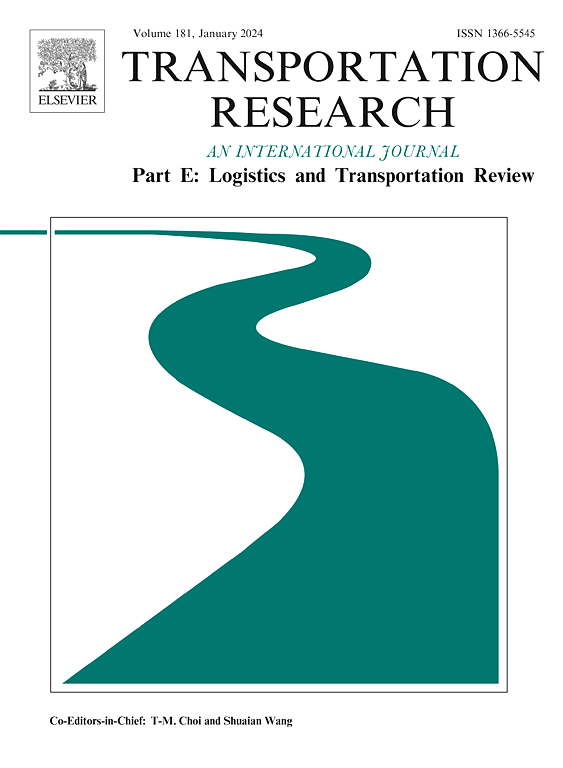Collaborative multidepot split delivery network design with three-dimensional loading constraints
IF 8.3
1区 工程技术
Q1 ECONOMICS
Transportation Research Part E-Logistics and Transportation Review
Pub Date : 2025-02-22
DOI:10.1016/j.tre.2025.104032
引用次数: 0
Abstract
The growing demand for bulky goods has spurred logistics firms to explore how to effectively manage and optimize multidepot delivery networks that consider three-dimensional loading constraints. The ability to divide customer demands and adaptively adjust vehicle compartments has significantly enhanced delivery efficiency and vehicle resource utilization. This study develops a collaborative multidepot vehicle routing problem that accommodates split deliveries and three-dimensional loading constraints. It begins by formulating a multi-objective mathematical model that aims to minimize total operating costs (TOC) and the number of vehicles used (NV) while maximizing the average loading rate (ALR). A novel hybrid algorithm combining an improved k-nearest neighbor clustering algorithm with an adaptive non-dominated sorting genetic algorithm-III (ANSGA-III) is developed to find Pareto optimal solutions. The improved k-nearest neighbor clustering algorithm is applied for the reallocation of customers. The ANSGA-III incorporates elite alteration and adaptive information feedback mechanisms to enhance the solution quality and algorithm convergence. Strategies for split loads and vehicle compartment partition are integrated into the ANSGA-III, facilitating the improvement of vehicle resource configuration efficiency. The superiority of the proposed algorithm is verified by comparison with those of the CPLEX solver for small-scale problems and against multi-objective particle swarm optimization, multi-objective evolutionary algorithms, and multi-objective ant colony optimization for medium-to-large problems. Additionally, the proposed model and algorithm are applied to a real-world case study in Chongqing city, China, and the result comparison from the initial network to optimized network shows that the TOC and NV reduced by 43.57% and 32.14%, respectively, while the ALR is improved by 33.51%. Furthermore, this study discusses the optimized results under varying the vehicle compartment partition strategies, contributing to the superiority of proposed approach in improving vehicle resource utilization efficiency. This represents significant cost savings of $2,934 and a reduction of six vehicles, along with a notable 23.35%% improvement in ALR compared to the scenario without compartment division. We also discuss various scenarios involving the split load strategies and different loading capacity schemes, and the computational results demonstrate that the proposed approach improves vehicle loading rates and reduces logistics operating costs. Specifically, the result comparison between the network with and without split load strategies shows that the TOC and ALR in each depot are improved by $2,128, $905, $1,265, $796, and 40.47%, 34.67%, 21.98%, 36.91%, respectively. The findings offer essential insights for promoting a digitally-intelligent and resource-efficient urban logistics system.
求助全文
约1分钟内获得全文
求助全文
来源期刊
CiteScore
16.20
自引率
16.00%
发文量
285
审稿时长
62 days
期刊介绍:
Transportation Research Part E: Logistics and Transportation Review is a reputable journal that publishes high-quality articles covering a wide range of topics in the field of logistics and transportation research. The journal welcomes submissions on various subjects, including transport economics, transport infrastructure and investment appraisal, evaluation of public policies related to transportation, empirical and analytical studies of logistics management practices and performance, logistics and operations models, and logistics and supply chain management.
Part E aims to provide informative and well-researched articles that contribute to the understanding and advancement of the field. The content of the journal is complementary to other prestigious journals in transportation research, such as Transportation Research Part A: Policy and Practice, Part B: Methodological, Part C: Emerging Technologies, Part D: Transport and Environment, and Part F: Traffic Psychology and Behaviour. Together, these journals form a comprehensive and cohesive reference for current research in transportation science.

 求助内容:
求助内容: 应助结果提醒方式:
应助结果提醒方式:


